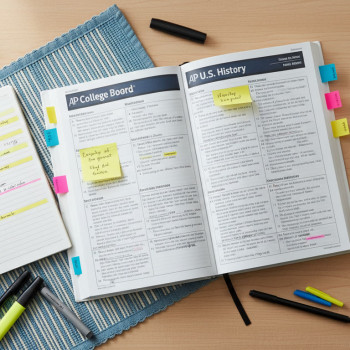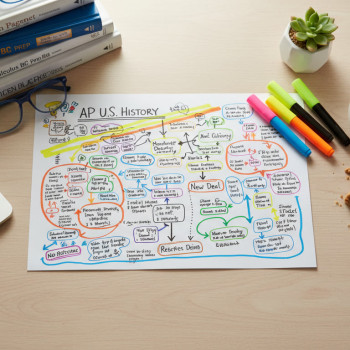Why the Thesis → Topic Sentence → Evidence Chain Matters
Every strong humanities paragraph is a little argument: a concise claim supported by a clear reason and a piece of proof. Whether you’re composing an AP English Literature timed essay, constructing an argument on AP United States History, or synthesizing ideas for AP World History, the chain from thesis to topic sentence to evidence is your paragraph’s backbone. Nail it, and your essays read like guided tours. Miss one link, and the reader gets lost.
This post gives you a friendly, practical walkthrough for turning a thesis into tight topic sentences and choosing evidence that actually earns points. It’s written for AP students who want to write more persuasively, save time under pressure, and build muscle memory for test day. Along the way we’ll include examples, comparisons, a useful table for quick reference, and small exercises you can use in study sessions or with a tutor. (If you want extra help, Sparkl’s personalized tutoring offers 1-on-1 guidance, tailored study plans, and expert tutors who can walk you through this exact process.)
The big idea: one claim per paragraph
Think of your thesis as the essay’s North Star — the overall argument. Each paragraph is a nibble of that star: a smaller, focused claim that advances the thesis. The topic sentence announces that nibble. The evidence is the bite that proves it. If you teach your brain to aim for one claim per paragraph, coherence and clarity follow naturally.
Step 1 — Craft a Thesis That Can Be Broken Down
Your thesis should do two things: answer the prompt directly and present an arguable line of reasoning that can be broken into separate points. Avoid vague generalities. A good thesis is specific enough that you can reasonably support it in the time you have.
Examples of tight vs. loose thesis statements
- Loose: “The novel shows many themes about identity and power.” (Too broad; hard to break into discrete paragraphs.)
- Tight: “In the novel, the protagonist’s changing language, shifting relationships, and strategic silence reveal a transfer of power that undermines the ruling class.” (Specific, and you can make three paragraphs: language, relationships, silence.)
Step 2 — Turn Each Thesis Component into a Topic Sentence
Once your thesis lists two to four discrete reasons or strands, each becomes the seed of a paragraph. Your topic sentence should do three tasks succinctly:
- State the paragraph’s claim clearly and directly.
- Link the claim to the thesis (explicitly or implicitly).
- Set up the kind of evidence you’ll use (textual quote, historical data, rhetorical feature, etc.).
Topic sentence formulas that work under time pressure
- “Because [reason], [subject] [does X]…”
- “[Subject]’s use of [device/choice] reveals [interpretation]…”
- “A close look at [event/scene/paragraph] shows that [claim]…”
Each formula cues you to both claim and evidence type. The more precise the hook, the easier it is to pick a quote or detail that fits.
Step 3 — Choose Evidence That Matches the Claim
Not all evidence is created equal. In AP rubrics, quality matters more than quantity: one well-chosen, well-explained piece of evidence often beats three weak ones. Match evidence to the claim you made in the topic sentence — if you claim a character is evasive, show a line of dialogue or a scene where they dodge an answer, not a description of their clothing.
Types of evidence in humanities AP exams
- Direct quotations (literature, rhetoric)
- Paraphrased passages or scenes
- Specific historical events, dates, policies (history exams)
- Statistics or documented outcomes (when appropriate)
- Author or speaker intent and rhetorical devices

Step 4 — Explain the Evidence — Don’t Just Drop It
This is the part where many students lose points. After you present evidence — a quote, a fact, a detail — you must connect it back to your topic sentence and, in turn, your thesis. Think of this as translating: “This detail looks like X, but here’s why it proves Y for our argument.” Always answer the reader’s question: “So what?”
A simple explanation scaffold
- Introduce the evidence briefly (one clause).
- Present the evidence — short quote or precise reference.
- Analyze: show how the evidence supports the topic sentence.
- Connect back to the thesis and to the paragraph’s role in the overall essay.
Concrete Example: Applying the Chain in AP Literature
Prompt (sample): “How does the narrator’s relationship with language shape identity in the passage?”
Thesis (example): “The narrator’s manipulation of language — via coded metaphors, ironic understatement, and shifting pronouns — constructs an identity that resists external definition and asserts internal authority.”
Paragraph breakdown
- Topic sentence (language/metaphors): “The narrator’s repeated use of coded animal metaphors reclaims agency by refusing society’s labels.”
- Evidence: Short quote containing the metaphor.
- Explanation: Unpack connotations, tone, and how the metaphor disrupts the reader’s expectations; tie to the thesis about asserting authority.
Concrete Example: Applying the Chain in AP History
Prompt (sample): “Evaluate the extent to which economic factors shaped political reforms in the 19th century.”
Thesis (example): “Economic pressures — industrial labor unrest, tariff debates, and credit crises — were the primary engines driving the era’s political reforms, though ideology shaped the framework of response.”
Paragraph breakdown
- Topic sentence (labor unrest): “Waves of industrial strikes forced lawmakers to consider labor regulations, revealing economics as a driving factor behind reform.”
- Evidence: Specific strike, year, and policy response.
- Explanation: Show cause and effect, using dates and policy names to anchor the point.
One Paragraph Framework You Can Use in 10–12 Minutes
When the clock is ticking on AP exams, use this compact template to build a paragraph that earns points for clarity, evidence, and analysis:
- 1 sentence Topic Sentence (claim + link to thesis)
- 1 sentence Introduce Evidence
- 1 short quote or specific detail
- 2–3 sentences Analyze the evidence
- 1 sentence Concluding link back to thesis / transition
Quick tips for timed writing
- Pick evidence you can analyze quickly — short quotes or well-memorized facts.
- Keep quotes short (one line) and weave them into your own sentence structure.
- Aim for clarity over flashiness. Precise claims and clean logic score higher than ornate language with weak analysis.
Common Pitfalls and How to Avoid Them
| Pitfall | Why It Hurts | Quick Fix |
|---|---|---|
| Topic sentence is too broad | Makes it hard to choose targeted evidence | Make it specific: name the device, event, or behavior you’ll discuss |
| Evidence is irrelevant or generic | Doesn’t support the claim; wastes time | Choose evidence that directly illustrates the topic sentence |
| Explanation paraphrases instead of analyzes | Shows comprehension but not insight | Focus on “how” and “why,” not just “what” |
| No connection back to thesis | Paragraph feels isolated | End with a sentence that links to the thesis or next paragraph |
Putting It Together: Sample Paragraph (AP Lit Style)
Topic sentence: “The narrator’s repeated use of coded animal metaphors reclaims agency by refusing society’s pejorative labels.”
Introduce evidence: “For instance, when she refers to herself as ‘the fox at dusk’ (line 32), the phrase does more than describe — it reframes.”
Evidence: “‘the fox at dusk’”
Explanation: By invoking the fox’s cunning and nocturnal independence, the narrator rejects daytime definitions imposed by others. The metaphor’s implicit image emphasizes self-reliance rather than the passivity the community expects. The word “dusk” complicates the metaphor: it suggests transition and control over the border between seen and unseen, mirroring how the narrator navigates public and private identities. In short, this small image transforms a social label into a strategic posture, reinforcing the essay’s thesis that language constructs resistance and self-authority.
How to Choose Evidence Efficiently During Review Sessions
When you study, build an “evidence bank” keyed to common themes and devices. Spend time categorizing a few powerful examples for each likely topic so you can retrieve them under time pressure.
Example evidence bank headings
- Identity — pronoun shifts, names, self-referential metaphors
- Power — speech acts, distribution of dialogue, controlling images
- Resistance — silence, coded language, subtextual actions
- Continuity/Change — turning points, legislative acts, pivotal lines
Mini-Exercise: Turn This Thesis Into Three Paragraphs
Try it now. Thesis: “In her memoir, the author uses memory, tone, and omission to shape a public image that masks private trauma.”
- Paragraph 1 topic sentence idea: memory — which memories are highlighted and how sequencing affects perception.
- Paragraph 2 topic sentence idea: tone — how ironic distance or warmth creates emotional distance.
- Paragraph 3 topic sentence idea: omission — what the text leaves out and why that absence is itself evidence.
For each paragraph, pick one concrete detail and write two sentences of analysis. If you practice this exercise with several prompts, it trains your brain to see structural opportunities quickly on exam day.

How Tutors and Targeted Help Speed the Learning Curve
Practice is essential, but targeted feedback makes practice efficient. Working with an experienced tutor — especially in a 1-on-1 setting — accelerates improvement because the tutor can: point out recurring weaknesses, model tight topic sentences, and recommend precise evidence that matches a variety of prompts. Personalized tutoring (like Sparkl’s personalized tutoring) can pair you with expert tutors who create tailored study plans and use AI-driven insights to pinpoint which paragraph skills need the most work.
Checklist for a High-Scoring Paragraph
- Does the topic sentence make a clear claim connected to the thesis?
- Is the evidence specific and directly relevant?
- Is the evidence quoted or described precisely (with line numbers, dates, or names when appropriate)?
- Does the analysis explain how the evidence supports the claim (move from “what” to “why”)?
- Is there a concluding or transitional line that ties the paragraph back to the thesis?
Final Notes: Style, Voice, and Exam Etiquette
Write with an active, confident voice. Avoid sweeping generalizations that you can’t support. Underline or briefly mark your quotes with context (e.g., name and year for a historical example, or speaker and scene for a literature quote) so graders can immediately see the relevance. Time-box practice essays so that your muscle memory knows how to pick evidence and write explanations within a set interval.
A few last pragmatic tips
- Pre-plan: Spend 3–5 minutes outlining your thesis and three main paragraph points before writing.
- Use signal phrases: “For example,” “This suggests,” “Consequently,” help graders follow your logic.
- Keep quotes brief and analyze them — your explanation is where the points live.
Wrap-Up: Make the Chain a Habit
The thesis → topic sentence → evidence chain isn’t a stunt — it’s a repeatable habit that turns messy notes into persuasive paragraphs. Practice deliberately: outline, pick targeted evidence, and explain with purpose. Over time, this structure will free you to focus more on insight and less on scrambling for relevance under timed conditions.
If you want guided practice, consider working with a tutor who can build a study plan around this exact chain and give live feedback on topic sentences and evidence choices. Sparkl’s personalized tutoring offers that kind of 1-on-1 guidance, tailored plans, and expert tutors who help you internalize these steps so your writing becomes faster, clearer, and more convincing.
Quick Takeaway
Thesis: your roadmap. Topic sentence: the paragraph’s destination. Evidence: the proof that you arrived. Explain: show why it matters. Chain these reliably, and AP graders will read your essays as purposeful, compelling arguments — exactly the kind of writing that earns high scores.
Appendix: One-Page Rapid Reference Table
| Component | Purpose | Example Starter |
|---|---|---|
| Thesis | Overall argument; answers the prompt | “Although X, Y because A, B, and C.” |
| Topic Sentence | Paragraph claim linked to thesis | “[Character/Policy/Author]’s use of [device/action] shows [claim].” |
| Evidence | Concrete support (quote, fact, date) | Short quote or specific event with citation |
| Explanation | Analyze how evidence proves the topic sentence | “This reveals… because… which shows…” |
| Wrap/Transition | Link back to thesis and move forward | “Therefore… / This suggests… / Consequently…” |
Want to Practice With Feedback?
If you’re serious about fast improvement, combine timed practice with feedback cycles: write, mark, revise, and repeat. Personalized tutors can shorten this loop by pointing to patterns in your work and prescribing exact drills. A few targeted sessions can often produce more progress than untargeted hours of practice.
Parting encouragement
Writing in the humanities is thinking on the page. When you control the thesis → topic sentence → evidence chain, you control the argument. That control is what turns good students into persuasive writers. Keep practicing, pick a few strong pieces of evidence for frequent themes, and lean on targeted help when you need it. You’ve got this.




















No Comments
Leave a comment Cancel